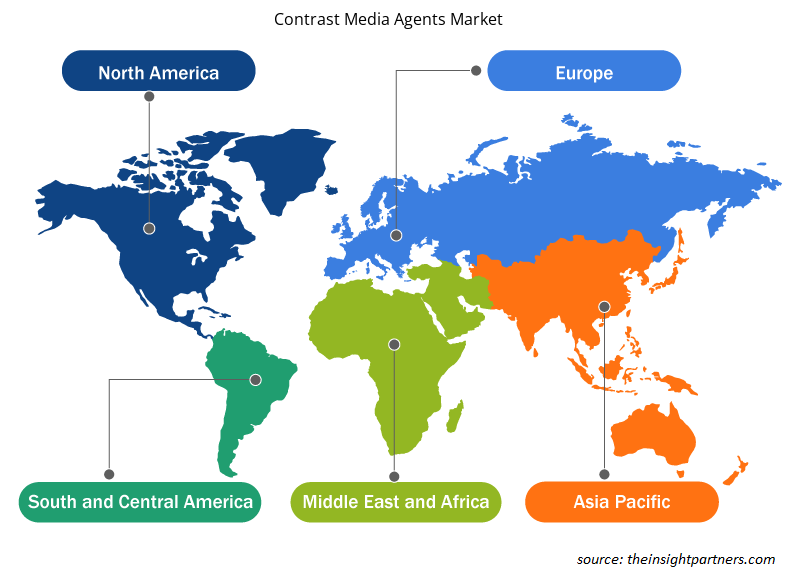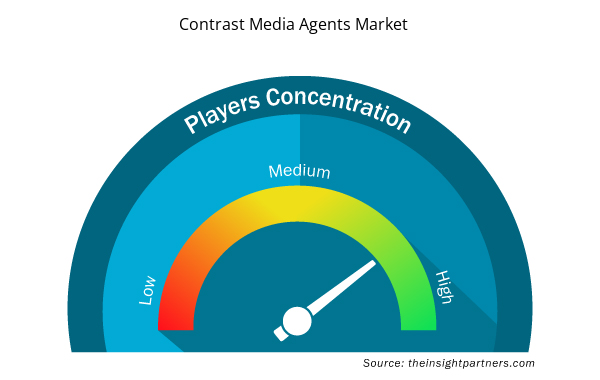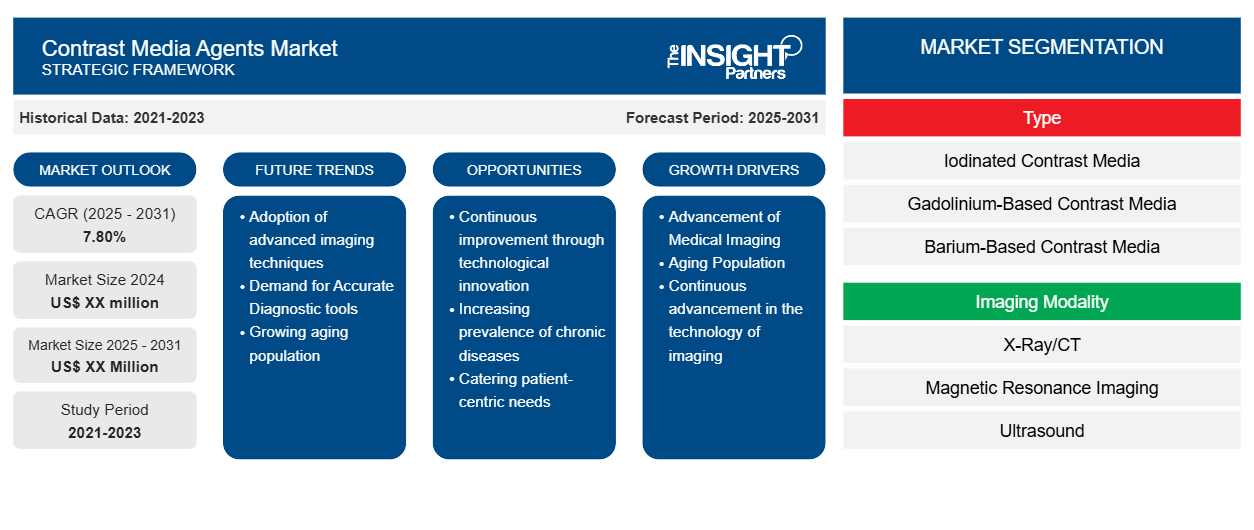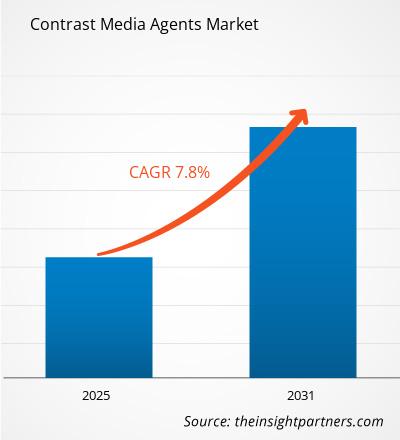Se espera que el mercado de agentes de medios de contraste registre una CAGR del 7,80 % entre 2024 y 2031, con un tamaño de mercado que se expandirá de US$ XX millones en 2024 a US$ XX millones en 2031.
El informe clasifica el mercado de agentes de medios de contraste por tipo, modalidad de imagenología, indicación y vía de administración. El informe considera el mercado, por tipo, para diferentes tipos de agentes de medios de contraste, como agentes yodados, a base de bario y a base de gadolinio, junto con un estudio sobre las diferentes vías de administración, como intravenosa, oral y rectal. Se realiza un análisis de los usuarios finales para hospitales, centros de diagnóstico por imágenes e instituciones de investigación, que muestra información sobre los impulsores de la demanda en diferentes entornos de atención médica.
Propósito del Informe
El informe Contrast Media Agents Market de The Insight Partners tiene como objetivo describir el panorama actual y el crecimiento futuro, los principales factores impulsores, los desafíos y las oportunidades. Esto proporcionará información a diversas partes interesadas del negocio, como:
- Proveedores/fabricantes de tecnología: Para comprender la dinámica cambiante del mercado y conocer las oportunidades potenciales de crecimiento, lo que les permitirá tomar decisiones estratégicas informadas.
- Inversionistas: Realizar un análisis exhaustivo de tendencias sobre la tasa de crecimiento del mercado, las proyecciones financieras del mercado y las oportunidades que existen en toda la cadena de valor.
- Órganos reguladores: Regular las políticas y vigilar las actividades del mercado con el objetivo de minimizar los abusos, preservar la confianza de los inversores y defender la integridad y estabilidad del mercado.
Segmentación del mercado de agentes de medios de contraste
Tipo
- Medios de contraste yodados
- Medios de contraste a base de gadolinio
- Medios de contraste a base de bario
- Medio de contraste de microburbujas
Modalidad de imagen
- Radiografía/TC
- Imágenes por resonancia magnética
- Ultrasonido
Indicación
- Trastornos cardiovasculares
- Cáncer
- Trastornos gastrointestinales
- Trastornos musculoesqueléticos
- Trastornos neurológicos
- Trastornos nefrológicos
Vía de administración
- Intravascular
- Oral
- Rectal
Personalice este informe según sus necesidades
Obtendrá personalización en cualquier informe, sin cargo, incluidas partes de este informe o análisis a nivel de país, paquete de datos de Excel, así como también grandes ofertas y descuentos para empresas emergentes y universidades.
- Obtenga las principales tendencias clave del mercado de este informe.Esta muestra GRATUITA incluirá análisis de datos, desde tendencias del mercado hasta estimaciones y pronósticos.
Factores impulsores del crecimiento del mercado de agentes de medios de contraste
- Avances en la imagenología médica: El mercado de los agentes de contraste se caracteriza por un fuerte crecimiento debido a un conjunto de factores influyentes que reflejan los avances en la imagenología médica y la creciente demanda de diagnóstico. Según la OMS, las enfermedades cardiovasculares son la principal causa de muerte en todo el mundo y se cobran anualmente unas 17,9 millones de vidas. Este terrible hecho genera una creciente demanda de servicios de diagnóstico mediante el uso de agentes de contraste para técnicas de imagenología como la resonancia magnética, las tomografías computarizadas y los rayos X.
- Envejecimiento de la población: La creciente tendencia al envejecimiento de la población es otro factor importante. Con una mayor esperanza de vida, las personas mayores tienen una mayor probabilidad de desarrollar enfermedades que requieran el uso de imágenes para un diagnóstico y tratamiento adecuados. Según las Naciones Unidas, para 2050, habrá aproximadamente 1.500 millones de personas de 65 años o más, casi el doble de la población en 2020. Esto crea una espiral ascendente en la demanda de imágenes diagnósticas y, lo que es más importante, una creciente necesidad de agentes de contraste de alta calidad para ayudar a crear imágenes más claras y precisas.
- El avance continuo en la tecnología de la imagenología: la modalidad también impulsa el crecimiento del mercado de agentes de contraste. Las innovaciones como la imagenología 3D, la imagenología en tiempo real y las técnicas de resolución mejorada han mejorado la eficacia y eficiencia en los procedimientos de diagnóstico. Por ejemplo, los avances en la resonancia magnética han aumentado enormemente el contraste de los tejidos blandos y, por lo tanto, la calidad del agente de contraste debe ser lo más fina posible para proporcionar imágenes nítidas y definidas. Por lo tanto, con la adopción de estas modalidades de imagenología avanzadas, se espera que la demanda de agentes de contraste especiales aumente en consecuencia.
Tendencias futuras del mercado de agentes de medios de contraste
- Adopción de técnicas avanzadas de diagnóstico por imagen: el desarrollo de modalidades como la resonancia magnética, la tomografía computarizada y la ecografía ha aumentado la necesidad de agentes de alta calidad que proporcionen imágenes más nítidas con mayor definición y resolución. La mejora continua a través de la innovación tecnológica en la claridad y el detalle de las imágenes significa que habrá una creciente necesidad de medios de contraste eficaces para mejorar la precisión diagnóstica entre los profesionales de la salud. Por ejemplo, se desarrollan microburbujas ultrapequeñas para aumentar la obtención de imágenes por ecografía y lograr una visualización clara del flujo sanguíneo y la perfusión tisular durante el diagnóstico de diversas enfermedades.
- Demanda de herramientas de diagnóstico precisas: Otra tendencia importante en el mercado de los medios de contraste es la creciente prevalencia de enfermedades crónicas, que impulsa la demanda de herramientas de diagnóstico precisas. La Organización Mundial de la Salud considera las enfermedades no transmisibles, como las enfermedades cardiovasculares y los cánceres, como las principales causas de mortalidad en el mundo. La creciente incidencia pone de relieve la necesidad de disponer de soluciones en el campo de la imagenología, ya que a menudo el diagnóstico temprano es bastante crucial en lo que respecta a los posibles resultados del tratamiento. La mayoría de los países han adoptado sistemas sanitarios que se centran en el diagnóstico y la atención tempranos; por tanto, su dependencia de los medios de contraste en dichos diagnósticos también ha aumentado significativamente.
- Envejecimiento de la población: el envejecimiento de la población es un factor determinante de las tendencias del mercado. De hecho, se estima que en el año 2050 habrá alrededor de 1.500 millones de personas de 65 años o más en todo el mundo, por lo que la demanda de servicios de diagnóstico por imágenes probablemente aumentará en consecuencia. Los adultos mayores son más propensos a padecer diferentes afecciones de salud, la mayoría de las cuales requieren servicios de diagnóstico por imágenes para su diagnóstico y tratamiento adecuado. El cambio demográfico primario requiere, de hecho, un enfoque que implique el uso de agentes de contraste diseñados teniendo en cuenta las necesidades y los requisitos de los pacientes de edad avanzada; esto exige innovación en el diseño de fórmulas para minimizar los riesgos y aumentar la seguridad.
- Panorama regulatorio en constante cambio: El entorno regulatorio en constante cambio ha puesto un mayor énfasis en las consideraciones de seguridad y eficacia. Varios organismos regulatorios están fomentando el desarrollo de agentes de contraste que serían más seguros y provocarían menos eventos adversos, especialmente en pacientes con situaciones prevalentes como insuficiencia renal o trastornos alérgicos. Por ejemplo, existe el desarrollo de agentes de contraste no yodados para pacientes que pueden tener sensibilidad al yodo. La tendencia, por lo tanto, no solo garantiza la seguridad, sino que también aumenta la población que puede someterse a imágenes mejoradas con contraste.
- Medicina personalizada: existe una tendencia creciente hacia la medicina personalizada, en la que los tratamientos y las estrategias de diagnóstico se adaptan al perfil específico del paciente. Esta tendencia también es válida para los medios de contraste, ya que los agentes específicos que se encuentran actualmente en fase de investigación tendrán imágenes específicas en determinadas condiciones o poblaciones. Estos avances ofrecerían una mayor precisión diagnóstica y eficacia terapéutica.
Oportunidades de mercado para agentes de medios de contraste
- Mejora continua a través de la innovación tecnológica: los avances tecnológicos en la claridad y el detalle de las imágenes implican que habrá una creciente necesidad de medios de contraste eficaces para mejorar la precisión diagnóstica entre los profesionales sanitarios. Por ejemplo, se han desarrollado microburbujas ultrapequeñas para aumentar la obtención de imágenes por ultrasonido y lograr una visualización clara del flujo sanguíneo y la perfusión tisular durante el diagnóstico de diversas enfermedades.
- La creciente prevalencia de enfermedades crónicas impulsa la demanda de herramientas de diagnóstico precisas. La Organización Mundial de la Salud considera las enfermedades no transmisibles, como las enfermedades cardiovasculares y los cánceres, como las principales causas de mortalidad en el mundo. La creciente incidencia pone de relieve la necesidad de disponer de soluciones en el campo de la imagenología, ya que a menudo el diagnóstico temprano es crucial en lo que respecta a los posibles resultados del tratamiento. La mayoría de los países han adoptado sistemas de salud que se centran en el diagnóstico y la atención tempranos; por lo tanto, su dependencia de los agentes de contraste para dichos diagnósticos también ha aumentado significativamente.
- Satisfacer las necesidades centradas en el paciente: Además, existe una tendencia creciente hacia la medicina personalizada, en la que los tratamientos y las estrategias de diagnóstico se adaptan al perfil específico del paciente. Esta tendencia también es válida para los medios de contraste, ya que los agentes específicos que se encuentran actualmente en investigación tendrán imágenes específicas en determinadas condiciones o poblaciones. Estos avances ofrecerían una mayor precisión diagnóstica y eficacia terapéutica.
Perspectivas regionales del mercado de agentes de medios de contraste
Los analistas de Insight Partners explicaron en detalle las tendencias y los factores regionales que influyen en el mercado de agentes de medios de contraste durante el período de pronóstico. Esta sección también analiza los segmentos y la geografía del mercado de agentes de medios de contraste en América del Norte, Europa, Asia Pacífico, Oriente Medio y África, y América del Sur y Central.

- Obtenga datos regionales específicos para el mercado de agentes de medios de contraste
Alcance del informe de mercado de agentes de medios de contraste
| Atributo del informe | Detalles |
|---|---|
| Tamaño del mercado en 2024 | XX millones de dólares estadounidenses |
| Tamaño del mercado en 2031 | US$ XX millones |
| CAGR global (2024 - 2031) | 7,80% |
| Datos históricos | 2021-2023 |
| Período de pronóstico | 2025-2031 |
| Segmentos cubiertos | Por tipo
|
| Regiones y países cubiertos | América del norte
|
| Líderes del mercado y perfiles de empresas clave |
|
Densidad de actores del mercado de agentes de medios de contraste: comprensión de su impacto en la dinámica empresarial
El mercado de agentes de medios de contraste está creciendo rápidamente, impulsado por la creciente demanda de los usuarios finales debido a factores como la evolución de las preferencias de los consumidores, los avances tecnológicos y una mayor conciencia de los beneficios del producto. A medida que aumenta la demanda, las empresas amplían sus ofertas, innovan para satisfacer las necesidades de los consumidores y aprovechan las tendencias emergentes, lo que impulsa aún más el crecimiento del mercado.
La densidad de actores del mercado se refiere a la distribución de las empresas o firmas que operan dentro de un mercado o industria en particular. Indica cuántos competidores (actores del mercado) están presentes en un espacio de mercado determinado en relación con su tamaño o valor total de mercado.
Las principales empresas que operan en el mercado de agentes de medios de contraste son:
- General Electric
- Bayer AG
- Braco
- GUERBET
Descargo de responsabilidad : Las empresas enumeradas anteriormente no están clasificadas en ningún orden particular.

- Obtenga una descripción general de los principales actores clave del mercado de agentes de medios de contraste
Puntos de venta clave
- Cobertura integral: el informe cubre de manera integral el análisis de productos, servicios, tipos y usuarios finales del mercado de agentes de medios de contraste, proporcionando un panorama holístico.
- Análisis de expertos: el informe se compila sobre la base de un profundo conocimiento de expertos y analistas de la industria.
- Información actualizada: El informe asegura relevancia comercial debido a su cobertura de información reciente y tendencias de datos.
- Opciones de personalización: este informe se puede personalizar para satisfacer los requisitos específicos del cliente y adaptarse adecuadamente a las estrategias comerciales.
Por lo tanto, el informe de investigación sobre el mercado de agentes de medios de contraste puede ayudar a abrir camino para descifrar y comprender el escenario de la industria y las perspectivas de crecimiento. Si bien puede haber algunas preocupaciones válidas, los beneficios generales de este informe tienden a superar las desventajas.
- Análisis histórico (2 años), año base, pronóstico (7 años) con CAGR
- Análisis PEST y FODA
- Tamaño del mercado Valor/volumen: global, regional, nacional
- Industria y panorama competitivo
- Conjunto de datos de Excel


- Social Employee Recognition System Market
- Medical and Research Grade Collagen Market
- Environmental Consulting Service Market
- Third Party Logistics Market
- Artificial Intelligence in Healthcare Diagnosis Market
- Skin Tightening Market
- Fish Protein Hydrolysate Market
- Public Key Infrastructure Market
- Cling Films Market
- Human Microbiome Market

Report Coverage
Revenue forecast, Company Analysis, Industry landscape, Growth factors, and Trends

Segment Covered
This text is related
to segments covered.

Regional Scope
North America, Europe, Asia Pacific, Middle East & Africa, South & Central America

Country Scope
This text is related
to country scope.
Preguntas frecuentes
The report can be delivered in PDF/PPT format; we can also share excel dataset based on the request.
Some of the customization options available based on request are additional 3-5 company profiles and country-specific analysis of 3-5 countries of your choice. Customizations are to be requested/discussed before making final order confirmation, as our team would review the same and check the feasibility.
General Electric, Bayer AG, Bracco, GUERBET, Lantheus Medical Imaging Inc, nanoPET Pharma GmbH, Unijules Life Sciences Ltd, Magnus Health Management Pvt Ltd are key players in this market
The market is expected to register a CAGR of 7.8% during 2023-2031
Major driving factors for the Contrast Media Agents Market include the prevalence of chronic diseases, aging of the population, improvement in technology related to imaging modalities, rise in the number of diagnostic procedures, innovative regulations, a focus on personalized medicine, and better awareness of early diagnosis of diseases. All these factors combined present a very strong environment where the growth and evolution of the contrast media agents market can thrive.
The trend shaping the radiological contrast media market includes the adoption of advanced imaging techniques, an increase in the prevalence of chronic diseases, and the older population, changing regulatory standards, a shift toward personalized medicine, and integration of digital technologies. Such factors, together, keep driving innovation and widening the scope of use of the contrast media agents and set this market on track for significant growth over the next few years.
Trends and growth analysis reports related to Life Sciences : READ MORE..
The List of Companies
1. General Electric
2. Bayer AG
3. Bracco
4. GUERBET
5. Lantheus Medical Imaging, Inc.
6. nanoPET Pharma GmbH
7. Unijules Life Sciences Ltd.
8. Magnus Health Management Pvt Ltd.
9. J.B.Chemicals and Pharmaceuticals Ltd.
10. Jodas Expoim
The Insight Partners performs research in 4 major stages: Data Collection & Secondary Research, Primary Research, Data Analysis and Data Triangulation & Final Review.
- Data Collection and Secondary Research:
As a market research and consulting firm operating from a decade, we have published and advised several client across the globe. First step for any study will start with an assessment of currently available data and insights from existing reports. Further, historical and current market information is collected from Investor Presentations, Annual Reports, SEC Filings, etc., and other information related to company’s performance and market positioning are gathered from Paid Databases (Factiva, Hoovers, and Reuters) and various other publications available in public domain.
Several associations trade associates, technical forums, institutes, societies and organization are accessed to gain technical as well as market related insights through their publications such as research papers, blogs and press releases related to the studies are referred to get cues about the market. Further, white papers, journals, magazines, and other news articles published in last 3 years are scrutinized and analyzed to understand the current market trends.
- Primary Research:
The primarily interview analysis comprise of data obtained from industry participants interview and answers to survey questions gathered by in-house primary team.
For primary research, interviews are conducted with industry experts/CEOs/Marketing Managers/VPs/Subject Matter Experts from both demand and supply side to get a 360-degree view of the market. The primary team conducts several interviews based on the complexity of the markets to understand the various market trends and dynamics which makes research more credible and precise.
A typical research interview fulfils the following functions:
- Provides first-hand information on the market size, market trends, growth trends, competitive landscape, and outlook
- Validates and strengthens in-house secondary research findings
- Develops the analysis team’s expertise and market understanding
Primary research involves email interactions and telephone interviews for each market, category, segment, and sub-segment across geographies. The participants who typically take part in such a process include, but are not limited to:
- Industry participants: VPs, business development managers, market intelligence managers and national sales managers
- Outside experts: Valuation experts, research analysts and key opinion leaders specializing in the electronics and semiconductor industry.
Below is the breakup of our primary respondents by company, designation, and region:

Once we receive the confirmation from primary research sources or primary respondents, we finalize the base year market estimation and forecast the data as per the macroeconomic and microeconomic factors assessed during data collection.
- Data Analysis:
Once data is validated through both secondary as well as primary respondents, we finalize the market estimations by hypothesis formulation and factor analysis at regional and country level.
- Macro-Economic Factor Analysis:
We analyse macroeconomic indicators such the gross domestic product (GDP), increase in the demand for goods and services across industries, technological advancement, regional economic growth, governmental policies, the influence of COVID-19, PEST analysis, and other aspects. This analysis aids in setting benchmarks for various nations/regions and approximating market splits. Additionally, the general trend of the aforementioned components aid in determining the market's development possibilities.
- Country Level Data:
Various factors that are especially aligned to the country are taken into account to determine the market size for a certain area and country, including the presence of vendors, such as headquarters and offices, the country's GDP, demand patterns, and industry growth. To comprehend the market dynamics for the nation, a number of growth variables, inhibitors, application areas, and current market trends are researched. The aforementioned elements aid in determining the country's overall market's growth potential.
- Company Profile:
The “Table of Contents” is formulated by listing and analyzing more than 25 - 30 companies operating in the market ecosystem across geographies. However, we profile only 10 companies as a standard practice in our syndicate reports. These 10 companies comprise leading, emerging, and regional players. Nonetheless, our analysis is not restricted to the 10 listed companies, we also analyze other companies present in the market to develop a holistic view and understand the prevailing trends. The “Company Profiles” section in the report covers key facts, business description, products & services, financial information, SWOT analysis, and key developments. The financial information presented is extracted from the annual reports and official documents of the publicly listed companies. Upon collecting the information for the sections of respective companies, we verify them via various primary sources and then compile the data in respective company profiles. The company level information helps us in deriving the base number as well as in forecasting the market size.
- Developing Base Number:
Aggregation of sales statistics (2020-2022) and macro-economic factor, and other secondary and primary research insights are utilized to arrive at base number and related market shares for 2022. The data gaps are identified in this step and relevant market data is analyzed, collected from paid primary interviews or databases. On finalizing the base year market size, forecasts are developed on the basis of macro-economic, industry and market growth factors and company level analysis.
- Data Triangulation and Final Review:
The market findings and base year market size calculations are validated from supply as well as demand side. Demand side validations are based on macro-economic factor analysis and benchmarks for respective regions and countries. In case of supply side validations, revenues of major companies are estimated (in case not available) based on industry benchmark, approximate number of employees, product portfolio, and primary interviews revenues are gathered. Further revenue from target product/service segment is assessed to avoid overshooting of market statistics. In case of heavy deviations between supply and demand side values, all thes steps are repeated to achieve synchronization.
We follow an iterative model, wherein we share our research findings with Subject Matter Experts (SME’s) and Key Opinion Leaders (KOLs) until consensus view of the market is not formulated – this model negates any drastic deviation in the opinions of experts. Only validated and universally acceptable research findings are quoted in our reports.
We have important check points that we use to validate our research findings – which we call – data triangulation, where we validate the information, we generate from secondary sources with primary interviews and then we re-validate with our internal data bases and Subject matter experts. This comprehensive model enables us to deliver high quality, reliable data in shortest possible time.


 Obtenga una muestra gratuita de este informe
Obtenga una muestra gratuita de este informe